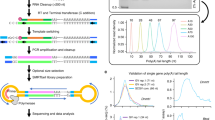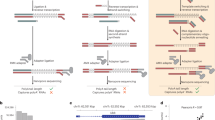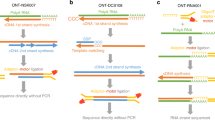Abstract
Poly(A) tails are added to the 3′ ends of most mRNAs in a non-templated manner and play essential roles in post-transcriptional regulation, including mRNA export, stability and translation. Measuring poly(A) tails is critical for understanding their regulatory roles in almost every aspect of biological and medical studies. Previous methods for analyzing poly(A) tails require large amounts of input RNA (microgram-level total RNA), which limits their application. We recently developed a poly(A) inclusive full-length RNA isoform-sequencing method (PAIso-seq) at single-oocyte-level sensitivity (a single mammalian oocyte contains ~0.5 ng of total RNA) based on PacBio sequencing that enabled accurate measurement of the poly(A) tail length and non-A residues within the body of poly(A) tails along with the full-length cDNA, providing the opportunity to study precious in vivo samples with very limited input material. Here, we describe a detailed protocol for PAIso-seq library preparation from single mouse oocytes or bulk oocyte samples. In addition, we provide a complete bioinformatic pipeline to perform the analysis from the raw data to downstream analysis. The minimum time required is ~14.5 h for PAIso-seq double-stranded cDNA preparation, 2 d for PacBio sequencing in HiFi mode and 8 h for the initial data analysis.
This is a preview of subscription content, access via your institution
Access options
Access Nature and 54 other Nature Portfolio journals
Get Nature+, our best-value online-access subscription
$29.99 / 30 days
cancel any time
Subscribe to this journal
Receive 12 print issues and online access
$259.00 per year
only $21.58 per issue
Buy this article
- Purchase on Springer Link
- Instant access to full article PDF
Prices may be subject to local taxes which are calculated during checkout





Similar content being viewed by others
Data availability
The data used in this study for bioinformatic analysis are from our published dataset18. The PAIso-seq CCS reads in fastq format we previously deposited18 are available in the NCBI Sequence Read Archive under the accession number PRJNA529588. For this protocol, we uploaded the raw subread data for the GV_rep2 and SCGV datasets, which had not been deposited before, to the GSA hosted by the National Genomic Data Center (https://ngdc.cncb.ac.cn/gsa/) under the accession number CRA005547. The CCS read data containing the PSIs in fastq format are available in GSA under the accession number CRA005706, and the accompanying pass number files are available in GitHub (https://github.com/Lulab-IGDB/PAIso-seq_scripts/blob/main/polyA_spike-in_pass_file/).
Code availability
Custom scripts used for data analysis are available at GitHub: https://github.com/Lulab-IGDB/PAIso-seq_scripts.
References
Subtelny, A. O., Eichhorn, S. W., Chen, G. R., Sive, H. & Bartel, D. P. Poly(A)-tail profiling reveals an embryonic switch in translational control. Nature 508, 66–71 (2014).
Lim, J. et al. Uridylation by TUT4 and TUT7 marks mRNA for degradation. Cell 159, 1365–1376 (2014).
Lim, J. et al. Mixed tailing by TENT4A and TENT4B shields mRNA from rapid deadenylation. Science 361, 701–704 (2018).
Lim, J., Lee, M., Son, A., Chang, H. & Kim, V. N. mTAIL-seq reveals dynamic poly(A) tail regulation in oocyte-to-embryo development. Genes Dev. 30, 1671–1682 (2016).
Ma, J., Fukuda, Y. & Schultz, R. M. Mobilization of dormant Cnot7 mRNA promotes deadenylation of maternal transcripts during mouse oocyte maturation. Biol. Reprod. 93, 48 (2015).
Kumar, A., Clerici, M., Muckenfuss, L. M., Passmore, L. A. & Jinek, M. Mechanistic insights into mRNA 3′-end processing. Curr. Opin. Struct. Biol. 59, 143–150 (2019).
Eckmann, C. R., Rammelt, C. & Wahle, E. Control of poly(A) tail length. Wiley Interdiscip. Rev. RNA 2, 348–361 (2011).
Charlesworth, A., Meijer, H. A. & de Moor, C. H. Specificity factors in cytoplasmic polyadenylation. Wiley Interdiscip. Rev. RNA 4, 437–461 (2013).
Sha, Q. Q. et al. CNOT6L couples the selective degradation of maternal transcripts to meiotic cell cycle progression in mouse oocyte. EMBO J. 37, e99333 (2018).
Yu, C. et al. BTG4 is a meiotic cell cycle-coupled maternal-zygotic-transition licensing factor in oocytes. Nat. Struct. Mol. Biol. 23, 387–394 (2016).
Pasternak, M., Pfender, S., Santhanam, B. & Schuh, M. The BTG4 and CAF1 complex prevents the spontaneous activation of eggs by deadenylating maternal mRNAs. Open Biol. 6, 160184 (2016).
Liu, Y. et al. BTG4 is a key regulator for maternal mRNA clearance during mouse early embryogenesis. J. Mol. Cell Biol. 8, 366–368 (2016).
Costa-Mattioli, M., Sossin, W. S., Klann, E. & Sonenberg, N. Translational control of long-lasting synaptic plasticity and memory. Neuron 61, 10–26 (2009).
Huang, Y. S., Jung, M. Y., Sarkissian, M. & Richter, J. D. N-methyl-D-aspartate receptor signaling results in Aurora kinase-catalyzed CPEB phosphorylation and alpha CaMKII mRNA polyadenylation at synapses. EMBO J. 21, 2139–2148 (2002).
Wu, L. et al. CPEB-mediated cytoplasmic polyadenylation and the regulation of experience-dependent translation of alpha-CaMKII mRNA at synapses. Neuron 21, 1129–1139 (1998).
Alarcon, J. M. et al. Selective modulation of some forms of schaffer collateral-CA1 synaptic plasticity in mice with a disruption of the CPEB-1 gene. Learn. Mem. 11, 318–327 (2004).
Chang, H., Lim, J., Ha, M. & Kim, V. N. TAIL-seq: genome-wide determination of poly(A) tail length and 3′ end modifications. Mol. Cell 53, 1044–1052 (2014).
Liu, Y., Nie, H., Liu, H. & Lu, F. Poly(A) inclusive RNA isoform sequencing (PAIso-seq) reveals wide-spread non-adenosine residues within RNA poly(A) tails. Nat. Commun. 10, 5292 (2019).
Legnini, I., Alles, J., Karaiskos, N., Ayoub, S. & Rajewsky, N. FLAM-seq: full-length mRNA sequencing reveals principles of poly(A) tail length control. Nat. Methods 16, 879–886 (2019).
Zhao, T. et al. Impact of poly(A)-tail G-content on Arabidopsis PAB binding and their role in enhancing translational efficiency. Genome Biol. 20, 189 (2019).
Eisen, T. J. et al. The dynamics of cytoplasmic mRNA metabolism. Mol. Cell 77, 786–799.e10 (2020).
Eisen, T. J., Eichhorn, S. W., Subtelny, A. O. & Bartel, D. P. MicroRNAs cause accelerated decay of short-tailed target mRNAs. Mol. Cell 77, 775–785.e8 (2020).
Harrison, P. F. et al. PAT-seq: a method to study the integration of 3′-UTR dynamics with gene expression in the eukaryotic transcriptome. RNA 21, 1502–1510 (2015).
Woo, Y. M. et al. TED-seq identifies the dynamics of poly(A) length during ER stress. Cell Rep. 24, 3630–3641.e7 (2018).
Yu, F. et al. Poly(A)-seq: a method for direct sequencing and analysis of the transcriptomic poly(A)-tails. PLoS One 15, e0234696 (2020).
Parker, M. T. et al. Nanopore direct RNA sequencing maps the complexity of Arabidopsis mRNA processing and m6A modification. eLife 9, e49658 (2020).
Workman, R. E. et al. Nanopore native RNA sequencing of a human poly(A) transcriptome. Nat. Methods 16, 1297–1305 (2019).
Roach, N. P. et al. The full-length transcriptome of C. elegans using direct RNA sequencing. Genome Res. 30, 299–312 (2020).
Kim, D. et al. The architecture of SARS-CoV-2 transcriptome. Cell 181, 914–921.e10 (2020).
Long, Y., Jia, J., Mo, W., Jin, X. & Zhai, J. FLEP-seq: simultaneous detection of RNA polymerase II position, splicing status, polyadenylation site and poly(A) tail length at genome-wide scale by single-molecule nascent RNA sequencing. Nat. Protoc. 16, 4355–4381 (2021).
Jia, J. et al. Post-transcriptional splicing of nascent RNA contributes to widespread intron retention in plants. Nat. Plants 6, 780–788 (2020).
Laehnemann, D., Borkhardt, A. & McHardy, A. C. Denoising DNA deep sequencing data—high-throughput sequencing errors and their correction. Brief. Bioinform. 17, 154–179 (2016).
Ross, M. G. et al. Characterizing and measuring bias in sequence data. Genome Biol. 14, R51 (2013).
Minoche, A. E., Dohm, J. C. & Himmelbauer, H. Evaluation of genomic high-throughput sequencing data generated on Illumina HiSeq and genome analyzer systems. Genome Biol. 12, R112 (2011).
Hebert, P. D. N. et al. A Sequel to Sanger: amplicon sequencing that scales. BMC Genomics 19, 219 (2018).
Zhang, Y. et al. Alternative polyadenylation: methods, mechanism, function, and role in cancer. J. Exp. Clin. Cancer Res. 40, 51 (2021).
Morgan, M., Kumar, L., Li, Y. & Baptissart, M. Post-transcriptional regulation in spermatogenesis: all RNA pathways lead to healthy sperm. Cell. Mol. Life Sci. 78, 8049–8071 (2021).
Liudkovska, V. & Dziembowski, A. Functions and mechanisms of RNA tailing by metazoan terminal nucleotidyltransferases. Wiley Interdiscip. Rev. RNA 12, e1622 (2021).
Kandhari, N., Kraupner-Taylor, C. A., Harrison, P. F., Powell, D. R. & Beilharz, T. H. The detection and bioinformatic analysis of alternative 3′ UTR isoforms as potential cancer biomarkers. Int. J. Mol. Sci. 22, 5322 (2021).
Yu, S. & Kim, V. N. A tale of non-canonical tails: gene regulation by post-transcriptional RNA tailing. Nat. Rev. Mol. Cell Biol. 21, 542–556 (2020).
Hu, S. B. et al. Protein arginine methyltransferase CARM1 attenuates the paraspeckle-mediated nuclear retention of mRNAs containing IRAlus. Genes Dev. 29, 630–645 (2015).
Wang, Y. et al. Genome-wide screening of NEAT1 regulators reveals cross-regulation between paraspeckles and mitochondria. Nat. Cell Biol. 20, 1145–1158 (2018).
Matz, M. et al. Amplification of cDNA ends based on template-switching effect and step-out PCR. Nucleic Acids Res. 27, 1558–1560 (1999).
Ramskold, D. et al. Full-length mRNA-Seq from single-cell levels of RNA and individual circulating tumor cells. Nat. Biotechnol. 30, 777–782 (2012).
Picelli, S. et al. Smart-seq2 for sensitive full-length transcriptome profiling in single cells. Nat. Methods 10, 1096–1098 (2013).
Zhu, Y. Y., Machleder, E. M., Chenchik, A., Li, R. & Siebert, P. D. Reverse transcriptase template switching: a SMART approach for full-length cDNA library construction. Biotechniques 30, 892–897 (2001).
Picelli, S. et al. Full-length RNA-seq from single cells using Smart-seq2. Nat. Protoc. 9, 171–181 (2014).
Kapteyn, J., He, R., McDowell, E. T. & Gang, D. R. Incorporation of non-natural nucleotides into template-switching oligonucleotides reduces background and improves cDNA synthesis from very small RNA samples. BMC Genomics 11, 413 (2010).
Wenger, A. M. et al. Accurate circular consensus long-read sequencing improves variant detection and assembly of a human genome. Nat. Biotechnol. 37, 1155–1162 (2019).
van Dijk, E. L., Jaszczyszyn, Y., Naquin, D. & Thermes, C. The third revolution in sequencing technology. Trends Genet. 34, 666–681 (2018).
Luo, C. et al. Superovulation strategies for 6 commonly used mouse strains. J. Am. Assoc. Lab. Anim. Sci. 50, 471–478 (2011).
Acknowledgements
We thank Hu Nie for help in the bioinformatic analysis. This work was supported by the National Key Research and Development Program of China (2018YFA0107001), the Strategic Priority Research Program of the Chinese Academy of Sciences (XDA24020203), the National Natural Science Foundation of China (31970588, 32170606 and 81891001), the Natural Science Foundation of Heilongjiang province (YQ2020C003), the China Postdoctoral Science Foundation (2020M670516 and 2020T130687) and the State Key Laboratory of Molecular Developmental Biology.
Author information
Authors and Affiliations
Contributions
Y.L., J.W. and F.L. conceived and designed the study. Y.L. developed the method and performed the experiments. Y.Z. performed part of the bioinformatic analysis. Y.L., J.W. and F.L. designed the computational pipeline, analyzed the data and wrote the manuscript.
Corresponding authors
Ethics declarations
Competing interests
Y.L. and F.L. are named inventors on a patent (number: 201910837492.2) filed by the Institute of Genetics and Developmental Biology covering the PAIso-seq method. The other authors declare no competing interests.
Peer review
Peer review information
Nature Protocols thanks Qingshun Quinn Li and the other, anonymous, reviewer(s) for their contribution to the peer review of this work. Additional initial assessment was performed by informal referee Andrzej Dziembowski.
Additional information
Publisher’s note Springer Nature remains neutral with regard to jurisdictional claims in published maps and institutional affiliations.
Related links
Key reference using this protocol
Liu, Y. et al. Nat. Commun. 10, 5292 (2019): https://doi.org/10.1038/s41467-019-13228-9
Rights and permissions
About this article
Cite this article
Liu, Y., Zhang, Y., Wang, J. et al. Transcriptome-wide measurement of poly(A) tail length and composition at subnanogram total RNA sensitivity by PAIso-seq. Nat Protoc 17, 1980–2007 (2022). https://doi.org/10.1038/s41596-022-00704-8
Received:
Accepted:
Published:
Issue Date:
DOI: https://doi.org/10.1038/s41596-022-00704-8
This article is cited by
-
Maternal NAT10 orchestrates oocyte meiotic cell-cycle progression and maturation in mice
Nature Communications (2023)
-
Remodeling of maternal mRNA through poly(A) tail orchestrates human oocyte-to-embryo transition
Nature Structural & Molecular Biology (2023)
-
Comprehensive analysis of mRNA poly(A) tails by PAIso-seq2
Science China Life Sciences (2023)
Comments
By submitting a comment you agree to abide by our Terms and Community Guidelines. If you find something abusive or that does not comply with our terms or guidelines please flag it as inappropriate.



